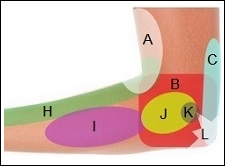- Home
- Elbow Pain Diagnosis
- Brachioradialis Pain
Brachioradialis Pain
Written By: Chloe Wilson BSc (Hons) Physiotherapy
Reviewed By: SPE Medical Review Board
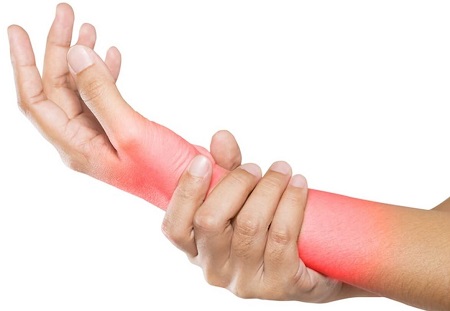
Brachioradialis pain causes tightness and pain in the forearm which may extend into the back of your hand, thumb and index finger.
Typically caused by overexertion, brachioradialis muscle pain causes problems with gripping, twisting and lifting movements such as drinking a cup of tea, using a screwdriver or a corkscrew.
The brachioradialis muscle runs down the back of the forearm and works with the biceps to flex (bend) the elbow. Biceps does most of the work when the forearm is supinated (palm facing upwards) but brachioradialis takes the lead when the forearm is pronated (palm facing downwards).
Brachioradialis also helps to twist the forearm and is a key stabiliser of the elbow and wrist.
Brachioradialis pain is a common cause of forearm pain and is often confused with tennis elbow and radial tunnel syndrome but they are each caused by different things and present slightly differently. Let’s find out more.
Anatomy & Function
Brachioradialis runs from the outer side of the humerus, just above the elbow (lateral supracondylar ridge), down the back of the forearm (dorsal aspect) to the bony lump just below the thumb side of the wrist (radial styloid).
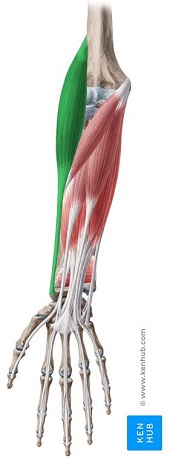
Brachioradialis works in a few different ways depending on the position of the arm and hand and what movements are being performed.
The main functions of the brachioradialis muscle are:
- Elbow Flexion: The brachioradialis muscle flexes the elbow, particularly when the forearm is pronated inwards i.e. palm facing downwards, and when quick movement is needed
- Pronation/Supination: Brachioradialis is slightly unusual in that it can both pronate and supinate your forearm, depending on the position of the forearm. Essentially it works to bring the forearm back to a neutral position so if the forearm is pronated, it will supinate, and if the forearm is supinated, it pronates back to neutral i.e. thumb pointing upwards
- Stabiliser: Brachioradialis helps support wrist extension e.g. when gripping something or picking an object up - it stops your wrist dropping down with the weight of the thing you are holding.
It also helps to support with supination and/or pronation when working against resistance. The best example of this is when you use a screwdriver.
And brachioradialis also helps to stabilise the elbow with particularly quick movements e.g. hook punch, and rapid flexion and extension movements in a neutral position e.g. hammering
What Causes Brachioradialis Pain?
Common causes of brachioradialis pain are:
- Repetitive Overuse: activities where the brachioradialis muscle is working repetitively including manual labour, certain sports e.g. weightlifting and racket sports, and even typing on the computer. Repetitive overuse is the most common cause of brachioradialis pain
- Sudden Overloading: e.g. picking up a particularly heavy object
- Direct Blow: forceful contact through the muscle e.g. sporting tackle, a fall onto the arm, or blunt force from a hard object
Overloading brachioradialis leads to tearing and inflammation in the muscle fibres and can result in trigger point formation i.e. small knots in the muscle.
Symptoms Of Brachioradialis Muscle Pain
Brachioradialis pain is a common cause of lateral elbow pain and forearm pain. The two most common symptoms of brachioradialis pain are forearm pain and tightness, and the affected area may be tender to touch.
Brachioradialis pain may be felt in the elbow (outer side), along the forearm and/or into the back of the hand, thumb and index finger.
There may be a sharp, shooting pain through the forearm at the time of injury or when doing certain activities, and a background ache at rest.
Typical activities that cause pain in the brachioradialis muscle include:
- Drinking From A Cup/Mug: particularly when putting the cup back down after drinking
- Using DIY Tools: e.g. screwdriver or hammer
- Opening Doors: especially ones with door knobs for handles
- Shaking Hands: with someone especially when using a firm grip
- Sports: e.g. racket sports (particularly backhands), golf, hockey, rock climbing and weightlifting
Over time, you may develop weakness in the forearm and may notice your grip strength gradually decreasing with brachioradialis pain.
Diagnosing Brachioradialis Pain
You doctor can usually diagnose brachioradialis pain. They will start by asking you about your symptoms, how and when they started, your normal daily activities and any sports that you play and your general health.
They will then examine you, looking at the range of motion and strength in your shoulder, elbow, wrist and hand. They will prefer various special tests to check the different structures in and around the elbow and forearm. Pain with resisted elbow flexion in a pronated position usually indicate brachioradialis pain. They may also send you for scans to look for bone and soft tissue damage e.g. x-rays, CT or MRI scans.
Differential Diagnosis
Brachioradialis pain is often misdiagnosed as tennis elbow or radial tunnel syndrome, both of which cause outer elbow pain and forearm pain so careful diagnosis is essential. They are all overuse injuries and are aggravated by gripping and twisting movements but there are subtle differences between them.
1. Tennis Elbow
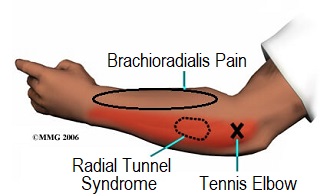
Pain from tennis elbow is typically centred around the lateral epicondyle on the outer elbow and may travel down the back of the forearm. It is caused by repetitive strain and overuse through the common extensor tendon.
Tennis elbow pain usually presents as an aching or burning sensation. The common extensor tendon is tender to touch and pain is usually worse with twisting and gripping movements. There may be weakness in the forearm and decreased grip strength. Sleep is often affected due to pain. Pain with resisted wrist extension or middle finger extension is indicative of tennis elbow.
Find out more about the common causes, symptoms, diagnosis and treatment options in the Tennis Elbow section.
2. Radial Tunnel Syndrome
With radial tunnel syndrome there is a problem with one of the nerves in the forearm rather than a muscle. Radial tunnel syndrome typically causes a nagging ache or burning pain on the outer forearm caused by pressure on the radial nerve.
Pain from radial tunnel syndrome tends to be worse with gripping and twisting movements and is often associated with weakness in the forearm and wrist.
Unlike brachioradialis pain and tennis elbow, radial tunnel syndrome never causes elbow pain – RTS pain is usually felt at least 3cm below the elbow. Pain with resisted supination often indicates radial tunnel syndrome.
You can find out more about the common causes, symptoms, diagnosis & treatment in the Radial Tunnel Syndrome section.
Here's a quick guide to help you tell the difference between brachioradialis pain, tennis elbow and radial tunnel syndrome.

If there is tingling or numbness in the hand, it is most likely to be carpal tunnel syndrome.
Treating Brachioradialis Pain
Brachioradialis pain can usually be treated at home with a combination of RICE, medication and exercises:
1. R.I.C.E.
RICE is the best place to start with any overuse or acute injury and involves a combination of:
Rest
rest is a really important part of brachioradialis pain treatment. With acute injuries, you should make sure to protect and rest the arm for the first 48-72 hours to prevent the risk of further injury.
With overuse injuries, it is important to rest from any aggravating activities until the pain starts to subside to give the muscle fibres time to heal and to allow any inflammation to settle. Failure to do so will delay the healing process, much like picking at a scab.
Ice
Regularly applying an ice pack to the forearm will help to reduce pain in the brachioradialis muscle and inflammation which in turn helps speed up the healing process.
Wrap some ice cubes or an ice pack in a towel and place them over the affected area of your forearm for 10-15 minutes at a time. Wait at least 2 hours between applications to allow the temperature to normalise – failure to do so can lead to an ice burn or even increased swelling.
The main goal of ice is to cause vasoconstriction – narrowing of the blood vessels to reduce the amount of swelling. If you leave an ice pack on too long, it actually causes the blood vessels to dilate resulting in increased blood flow and inflammation.
Compression
Wearing a tubigrip compression bandage can help to reduce swelling and provide support for the forearm if it is feeling weak. Tubigrip should be worn double thickness from the elbow to the hand – simply cut a small hole for your thumb to fit through. Make sure to take the tubigrip off overnight.
Elevation
Resting with the forearm raised above the level of your heart helps to reduce any swelling in the forearm associated with brachioradialis pain. Make sure your hand is elevated as well – you want any excess fluid to drain towards the arm pit where it can be reabsorbed by the lymphatic system rather than pooling in your hand.
Elevation is usually only necessary when the brachioradialis pain is due to direct trauma to the forearm, rather than overuse, where there may be some bleeding in the soft tissues from the injury.
2. Medication
Cver the counter pain relief e.g. paracetamol/acetaminophen and non-steroidal anti-inflammatories e.g. ibuprofen/Advil can help to manage brachioradialis pain and swelling. Always check with your doctor or pharmacist before starting any medication
3. Exercises
Once your brachioradialis pain is starting to settle, you can start working on an exercise program of forearm strengthening and stretching exercises.
Isometric Exercises
Exercises are an important part of brachioradialis pain treatment and isometric Exercises are the best place to start. With isometric exercises, you work on activating the muscle statically. This gets the muscle contracting without shortening or lengthening allowing the muscle to work but without placing any tension through the muscle fibres to reduce the risk of further injury. There are a few different ways to do this isometric brachioradialis exercises:
- Ball Squeezes: hold a squashy ball e.g. tennis ball in your hand and squeeze the ball, holding for 5 seconds each time. Repeat 10-30 times
- Resisted Elbow Flexion: Sit or stand with your elbow by your side and bent 90o. Turn your forearm so your thumb is pointing up towards the ceiling and place your other hand over your forearm, near you wrist. Gently push down through your forearm but resist the movement so that your arm doesn’t move. Hold for 3-5 seconds and repeat 10-25 times.
Range Of Motion Exercises
It is important to keep your wrist and elbow moving with range of motion exercises so they don’t stiffen or tighten up with brachioradialis pain. Think of them as really gentle stretching exercises.
- Elbow Flexion/Extension: with your arm by your side, palm facing your body, bend your elbow up as much as you can and then slowly lower back down until the elbow is fully straight. Repeat 10-20 times
- Pronation/Supination: Sit with your arm by your side, elbow bent 90 degrees. Slowly turn your palm up towards the ceiling as far as you can go (supination) and then turn the palm back down (pronation). Repeat 10-20 times
- Wrist Flexion/Extension: Rest your forearm on a table or chair arm and make a fist, with your thumb at the top. Keeping your forearm still, bend the wrist down into flexion and then bring it back as far as is comfortable into extension. Repeat 10-20 times
Stretches
Once you are comfortable doing isometric and range of motion exercises and the pain in your brachioradialis muscle is under control, you can start doing some stretches to regain full flexibility in the muscle. This will help reduce the chance of recurrent problems in the future.
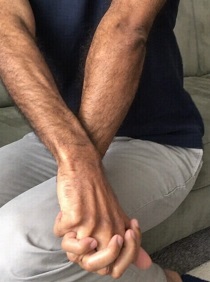
- Sit with your arm by your side, elbow straight
- Turn your forearm inwards as far as you can so that your palm faces away from your body
- To get more of a stretch, grasp the hand with your opposite hand and bend the wrist down by interlacing your fingers
- You should feel a stretch in the back of your forearm. Hold for 30 seconds and repeat 3 times
Strengthening Exercises
The final stage of rehab with brachioradialis muscle pain is exercises to strengthen the muscle so it can cope with the daily demands you put on it.
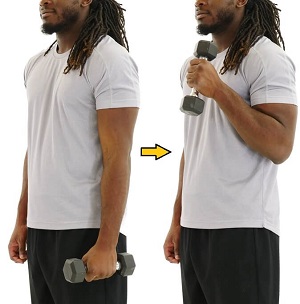
- Hammer Curls: Sitting or standing, hold a weight in your hand with your arm by your side, thumb pointing upwards.
Bend your elbow and bring the weight up towards your shoulder. Then slowly lower back down until you elbow is fully straight.
Repeat 10-30 times, keeping your palm facing your body throughout.
Hammer curls are very similar to traditional bicep curls, but by pronating the forearm to neutral you target the brachioradialis muscle.
- Theraband Curls: Stand on a resistance band with your feet hip width apart and grasp either end of the band in your hands, thumbs uppermost so your palms face your body.
Slowly bend both elbows, pulling the band up as high as you can. Hold for a couple of seconds and slowly lower the band back down until your elbows are straight.
Holding closer to the ends of the band reduces the tension, making it easier, whereas holding further down the band takes up the slack and places more tension through the band making your brachioradialis muscle work harder.
- Reverse Barbell Curls: Place both hands over the top of the barbell with your palms facing downwards and grip hold of the bar.
Keeping your wrist in neutral, bend both elbows and bring the bar up to your shoulders.
Hold for a couple of seconds and slowly lower down until your elbows are fully straight.
You may be used to doing barbell curls with your palms facing upwards, but pronating your forearms makes brachioradialis do a majority of the work rather than your biceps.
How To Prevent Brachioradialis Pain
Prevention is always better than cure and that goes for brachioradialis pain, so try the following:
- Warm Up: before activities that may strain your brachioradialis muscle. This may involve a combination of stretches, gentle strengthening exercises and low level cardiovascular work to get your body ready for action
- Stretches: Regularly perform brachioradialis stretches, not just before and after sports but also before doing activities such as DIY. The same goes if you spend long periods typing each day
- Take A Break: if you are doing activities for long periods to give your muscles a chance to recover
- Seek Prompt Treatment: if you start developing brachioradialis pain – the earlier you start treatment, the quicker you are likely to recover
Summary
- Brachioradialis pain causes pain, tightness and weakness on the outer forearm which may extend into the back of the hand, thumb and index finger
- Brachioradialis muscle pain may be caused by repetitive overuse, usually from gripping and twisting movements, but can occur due to a one-off injury
- Pain in the brachioradialis muscle is often worse when doing gripping and twisting activities e.g. using hand tools, opening doors and drinking a cup of coffee
- Sports commonly associated with brachioradialis pain include racket sports, golf, weightlifting and rock climbing
- Brachioradialis muscle pain can usually be treated at home with a combination of RICE (rest, ice, compression, and elevation), OTC medications and exercises
- Brachioradialis pain is often confused with Tennis Elbow or Radial Tunnel Syndrome all of which causes outer elbow pain and forearm pain
- Most people recover from brachioradialis pain within a few weeks, but it is important to avoid aggravating activities until the pain has settled otherwise it can take longer to recover
Related Articles
Page Last Updated: February 4th, 2025
Next Review Due: February 4th, 2027

